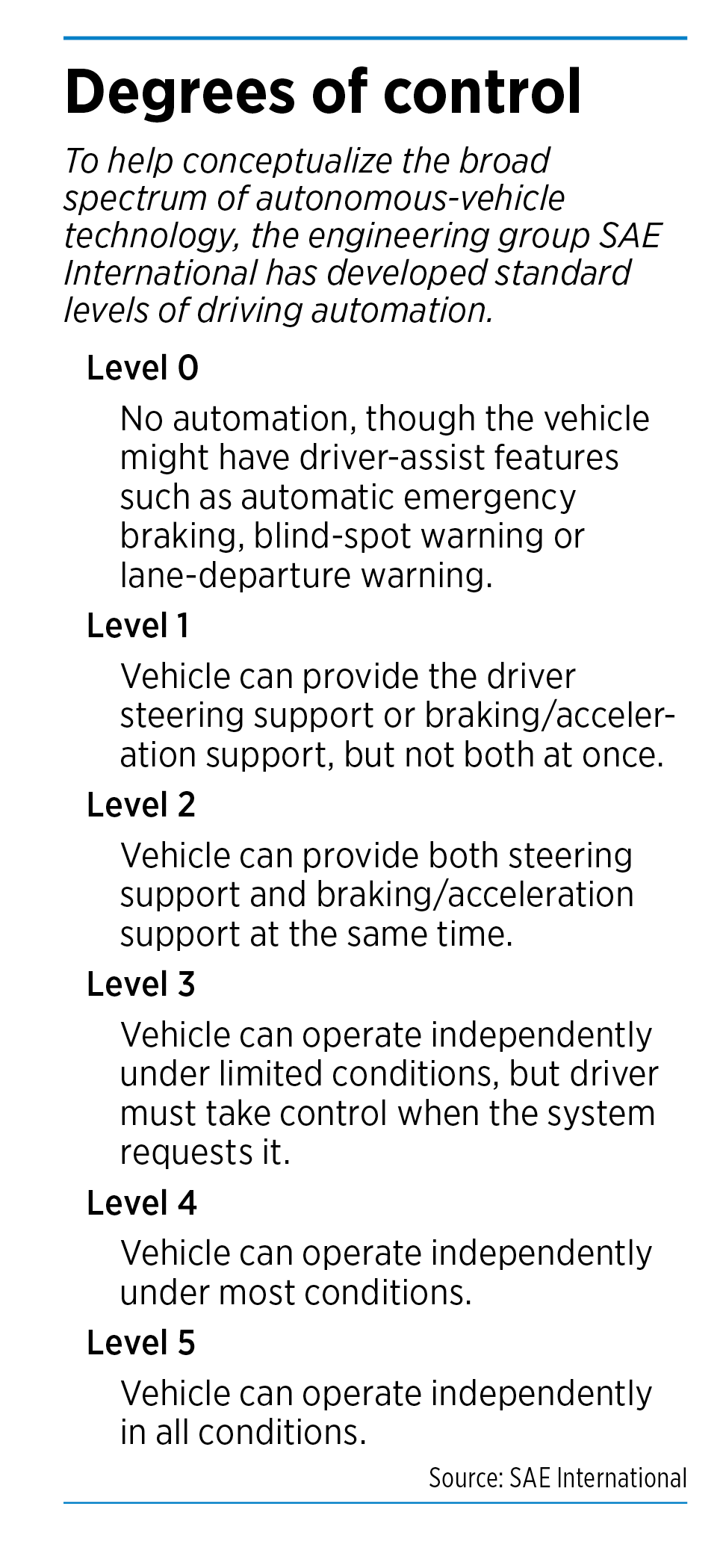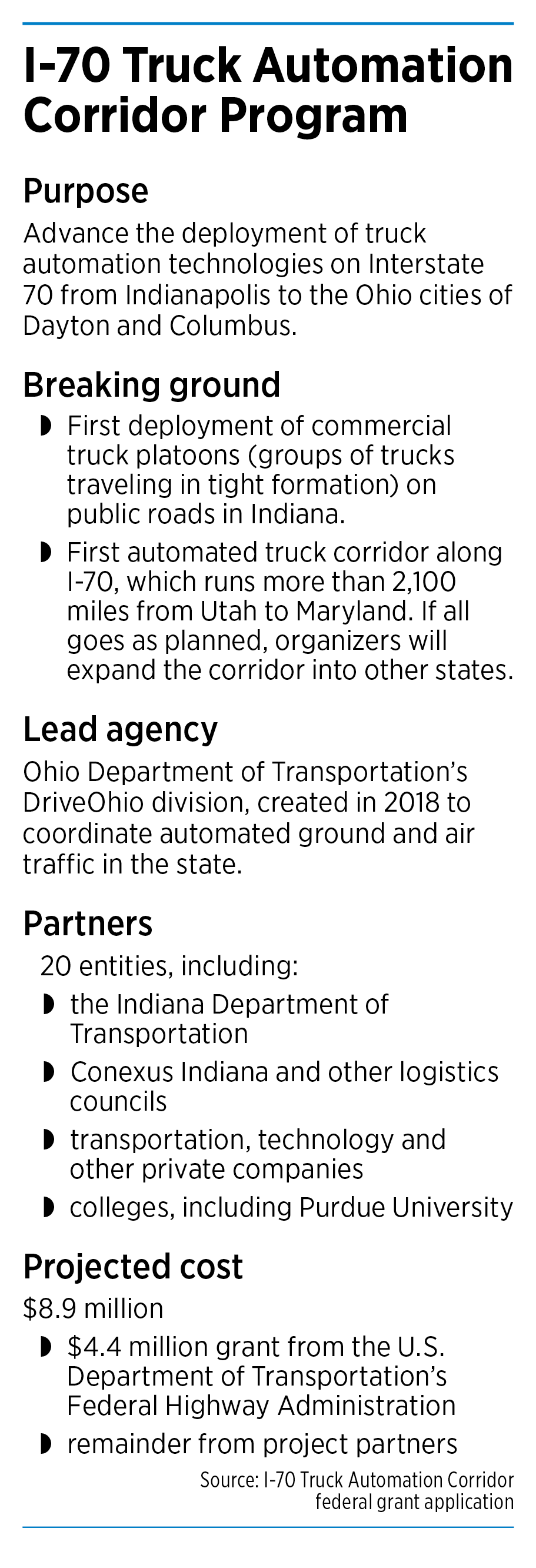Subscriber Benefit
As a subscriber you can listen to articles at work, in the car, or while you work out. Subscribe NowIt might be many years before fully autonomous, no-driver-required vehicles are a common sight on public highways—but transportation officials in Indiana and Ohio are laying the groundwork now for that day.
In June, the Indiana Department of Transportation and the Ohio Department of Transportation received a $4.4 million federal grant to prepare for, and advance the use of, semi-autonomous and autonomous truck traffic on the states’ highways.

The four-year project will put semi-autonomous commercial trucks—with drivers in them at all times—on Interstate 70, the Indiana Toll Road and the Ohio Turnpike. The project also will involve gathering data about the vehicles’ performance, sharing that data with project partners, and analyzing I-70 itself to determine the highway’s readiness for autonomous vehicles.
Most of the work will focus on I-70 between Indianapolis and Columbus. Project organizers say the effort will be the first of its kind on I-70—which runs more than 2,100 miles from Utah to Maryland—and could serve as a model for other states.
“There’s going to be a lot to learn,” said Luke Stedke, a spokesman for Drive Ohio, a division of the Ohio Department of Transportation. “Hopefully, some of the stuff we’re developing will be best practices for the U.S. through the [federal] Department of Transportation.”
Drive Ohio, the entity that applied for the I-70 grant, was formed in 2018 to focus on deployment of automated vehicles.
The federal grant will fund half of the project. The other half will come from the project’s partners—a group of 16 entities, including logistics councils and universities in Indiana and Ohio, technology vendors, trucking fleet operators, and technical partners.
Certainly, vehicles with different levels of automation are already traveling on roads and test tracks around the United States. Google spinoff Waymo, for instance, says its vehicles have driven more than 20 million miles on public roads in 25 cities, and it has tested its self-driving semi, the Waymo Via, in California, Arizona and Atlanta.

What distinguishes the I-70 project, organizers say, is that the trucks here will travel across state lines, and they won’t be demonstration vehicles: They’ll be actual fleet vehicles in revenue service, hauling loads for customers.
Trucking company JAT of Fort Wayne, for instance, will participate, hauling freight in Navistar trucks that use Bosch platooning technology.
 Platooning technology allows two or more vehicles to communicate with each other and safely travel very close together, reducing wind resistance and improving fuel efficiency.
Platooning technology allows two or more vehicles to communicate with each other and safely travel very close together, reducing wind resistance and improving fuel efficiency.
“In this [project], we’re actually working with existing logistics partners that are moving freight on I-70,” said Pam Fisher, INDOT’s director of economic development and special initiatives. “This is real-world logistics companies utilizing this technology and giving us insight.”
Project leaders plan to share what they learn with the logistics industry, as well as with other states and the U.S. Department of Transportation, to advance safe adoption of the technology.
“We’re trying to demonstrate the technology in revenue service, but we’re also trying to mature it at the same time,” Drive Ohio’s Stedke said.
Trucking focus

To date, much of the buzz about autonomous vehicles has focused on passenger cars. But transportation officials predict that Class 8 trucks—18-wheel semis—will be what first gain traction in Indiana and Ohio.
“It just seems like that’s where a lot of the energy is moving right now,” Stedke said.
Because of Indiana’s reputation as a logistics and freight powerhouse, Fisher said, INDOT is concentrating its autonomous-vehicle efforts on heavy trucks. “It makes more sense for us to focus on that particular area and to be supportive of that.”
The project is focusing on I-70 because of its heavy concentration of truck traffic, and because both the Indianapolis and Columbus airports have significant freight operations.
According to the Federal Aviation Administration, Indianapolis International Airport—a FedEx hub—last year ranked eighth of 141 U.S. airports in the amount of freight it handled. Rickenbacker International Airport in Columbus ranked 27th.
The trucks involved in the I-70 project will use various levels of automated technology.

Under a scale developed by SAE International, Level 1, which is already commercially available, includes driver-assistance features like lane-centering technology and adaptive cruise control. Level 5 is the highest level, in which a vehicle can handle driving in all conditions without the presence of a human driver.
Following a planning period that’s expected to last up to a year, semis in the project will begin traveling I-70 in two-truck platoons, Stedke said.
After that, trucks with Level 2 automation will hit the road. Level 2 automation, which is not quite yet commercially available, can control the vehicle’s steering and braking/acceleration at the same time.
The project also plans to deploy trucks with Level 4 automation along the Indiana Toll Road and the Ohio Turnpike.
Level 4 vehicles can operate totally autonomously in many road and weather conditions, with a human driver in control at other times. Level 4 technology is in the R&D stage now, but project organizers expect it to be available for deployment within a few years.
The trucking industry sees significant advantages to systems in which a human driver is aboard but only has to intervene at certain times—a dynamic that could boost truck productivity and shrink the number of accidents caused by fatigue or driver distraction.
 But the largest economic payoff would come from fully autonomous trucks. A 2018 report by the consulting firm McKinsey & Co. found that full autonomy would save the U.S. for-hire trucking industry $85 billion to $125 billion annually.
But the largest economic payoff would come from fully autonomous trucks. A 2018 report by the consulting firm McKinsey & Co. found that full autonomy would save the U.S. for-hire trucking industry $85 billion to $125 billion annually.
Assessing the highway
The $4.4 million federal grant also will fund an “audit” of I-70 to see what needs to be done to ready the interstate for autonomous vehicles.
Perhaps, for instance, faded lane markings need to be replaced so vehicles’ sensors can detect them more easily. Or maybe some type of roadside technology will need to be installed.
As a rule, the more advanced autonomous technology becomes, the greater the possibility that infrastructure changes will be required, said Greg Shaver, a professor of mechanical engineering at Purdue University.
Purdue is a partner on the I-70 project, and it’s also working with INDOT and other partners on a separate federally funded project focused on truck platooning.
For instance, Shaver said, it might make sense to create a separate lane of traffic for vehicles operating at autonomous levels 3, 4 or 5.
“There may be more peace of mind that we would all have if that driverless truck were operating in a dedicated lane.”
Solo autonomous trucks operating at levels 4 and 5 also might require physical lane separations, special lane markers, signs and sensors embedded in the road, he said.
Shaver predicted it will be at least 10 years before solo Level 4 autonomous vehicles are in widespread use.
The timeline, he said, depends not only on technology but also on factors ranging from enabling rulemaking to infrastructure to how quickly customers embrace the technology.
“It’s never just about the technology, or the regulations, or the infrastructure,” Shaver said. “The moons have to align.”
That being true, he said, the I-70 project is important because it takes time to create that alignment.
Robert Haag, vice president of operations at the Indianapolis-based trucking firm Perfect Transportation LLC and manufacturer Perfect Pallets, said it could be more like 30 to 40 years before Level 4 automation comes into widespread commercial use.
Haag, whose companies make pallets and operate a fleet of more than 40 trucks, also is on the boards of the Indiana Motor Truck Association and the American Trucking Associations.
He said fleet owners will have to believe the technology is worth the extra cost. In addition, government regulations and insurance policies, along with public sentiment, will have to support the technology.
Haag, who is not involved in the I-70 project, said this endeavor and similar studies are important even if full automation is decades away.
“It’s programs like these that do generate data that companies can use to build these technologies,” he said. “I think programs like this are essential to getting us to that next step.”•
Please enable JavaScript to view this content.


I can only imagine the damage if a computer glitch or mud-smirched sensor sends a loaded semi-trailer truck into a line of stopped cars. It’s clear the goal is to eliminate the cost of a live driver, but I won’t feel safe on the roads unless there’s a driver in the truck at all times.
Technology can be of great assistance to human beings, but it should not be a replacement for vehicle drivers. New situations arise that are not anticipated and not programmed into technology. While humans are not perfect, neither is technology. Using both improves both. Let’s not sacrifice lives to valueless technology.
Great idea! Let’s make I-70 even more deadly…..
Seems there are many other highway systems/areas to test autonomous trucks…
As you note, I-70 between Columbus and Indy is a terrible stretch. I frequently drive it each day to the border and until it’s free of construction and is 3 lanes each way, this is a terrible location to “test” this out.
Even an effective mandatory Level 1/2 system would be a substantial improvement in safety. Over 4000 people die in the US each year due to large trucks, and more than 10% of traffic deaths are due to a large truck.
Twice in the last few years a HUMAN driver has been at the wheel when they killed one of my friends due to their negligence. Whole law firms exist to prey on the victims and the trucking companies alike – BETTER TRUCKS WILL SAVE LIVES.
I thought driverless cars were scary. Now we are going to have driverless 18 wheeler?! How terrifyingly stupid is that?An accident waiting to happen as they say!
How is our Auto insurance going to handle an accident by a driverless vehicle?
Better yet, if you are a driver, you will participating in the elimination of your job. What a great incentive.